





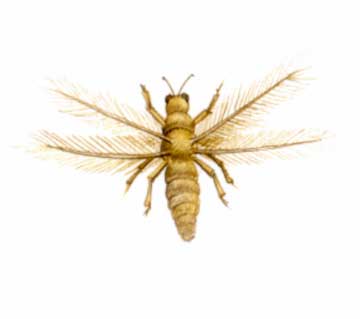 Thrip
Thrip
Thrips: Adult thrips are about 1/16-inch long and usually have dark bodies with four fringed wings. Their small size makes them difficult to detect in the garden. They mainly attack tender young leaves, flower stalks, and flower buds. Spray young foliage, developing buds, and the soil around the bush with an insecticide containing acephate (such as Orthene or Isotox).
Click here to learn natural ways to control garden pests.
continue reading belowCane borer: This insect is the maggot of the eggs laid by sawflies or carpenter bees in the freshly-cut cane of the rose after pruning. The telltale sign is the neatly-punctured hole visible on the top of the cane. To remove the pest, cut several inches down the cane until there are no longer signs of the maggot or pith-eaten core. Seal all pruning cuts with pruning sealer.
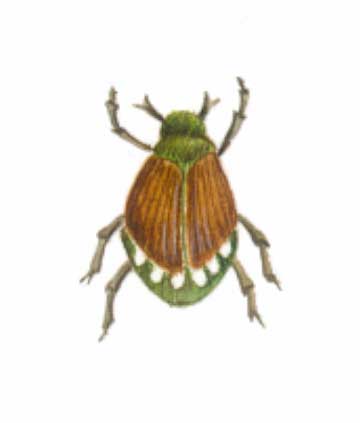 Japanese Beetle
Japanese Beetle
Japanese beetle, Fuller rose beetle: These are two beetles that will indiscriminately eat parts of the foliage and sometimes the flowers. Beetles can be picked off the bush by hand. Or spray foliage and flowers with an insecticide containing acephate.
Leaf miner: This insect is easily spotted on the foliate by the appearance of irregular white chain-like blisters containing its grub. Foliage should be removed and discarded to prevent further infestation.
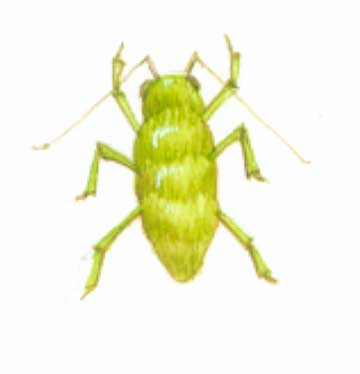 Spittle Bug
Spittle Bug
Spittle bug: This small, greenish-yellow insect always hides inside a circular mass of white foam on the surface of new stems, usually during the development of the first bloom cycle in early spring. A strong jet spray of water will remove the foam and the insect.
Virus: Two viral infections sometimes attack roses, appearing as yellow or cream veining that gives the foliage a variegated look. Vein banding mosaic is not a serious problem. Line pattern rose mosaic, however, can weaken the plant and cause death. Remove and destroy plants with either of these two infections to avoid spreading in the garden.
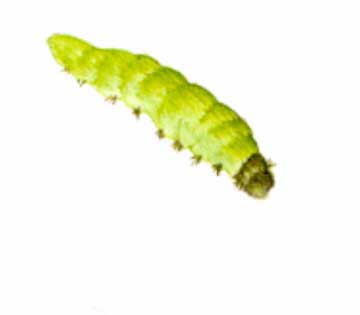 Roseslug
Roseslug
Roseslug: When you detect new foliage with a skeletonized pattern indicating the foliage has been eaten (but not the vein structure), then chances are the roseslug has been at work. It is best to remove the infected foliage or spray with an insecticide that contains acephate or diazinon.
Rust: This fungus tends to invade the garden when moisture levels are high. It grows on the undersides of the foliage in little red clusters. Control with fungicide containing triforine or chlorothalonil.
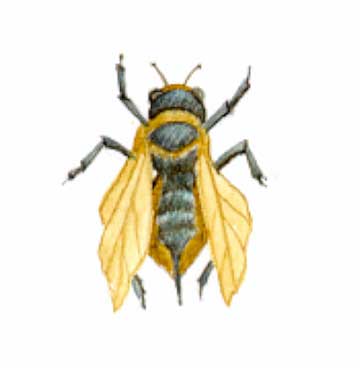 Leaf Cutter Bee
Leaf Cutter Bee
Leaf cutter bee: As its name implies, this very small yellowish-green insect jumps on the undersides of foliage to feast, often leaving its white skin behind. The damage caused by this insect can often result in defoliation. Use of an insecticide containing acephate will help prevent it from establishing a strong colony.
Rose scale: This insect hides under gray scales, normally on old canes or stems. It feeds by sucking the sap, weakening the plant. If localized, it can often be removed with a fingernail. Or spray with an insecticide containing acephate or diazinon.
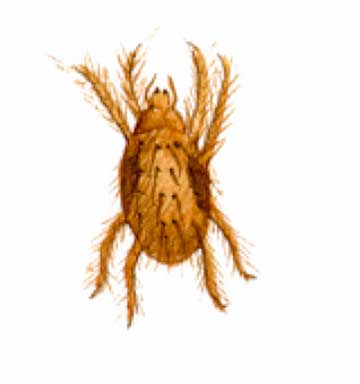 Spider Mite
Spider Mite
Spider mite: The spider mite establishes huge colonies underneath leaves, giving the appearance of salt-and-pepper particles. If detected early enough, the problem can be controlled chemically with insecticides containing acephate, directing the spray to the underside of the leaves. If you prefer, a fine misting with water to the undersides of the foliage will wash many of the mites to ground level, and since they are unable to fly they will die on the soil surface.
Blackspot: This fungus causes circular black spots on the surface of leaves. It tends to thrive in warm, wet climates with high humidity. Control with fungicide containing triforine or chlorothalonil. Practice good sanitation; pick up fallen leaves and place in trash; do not compost them.
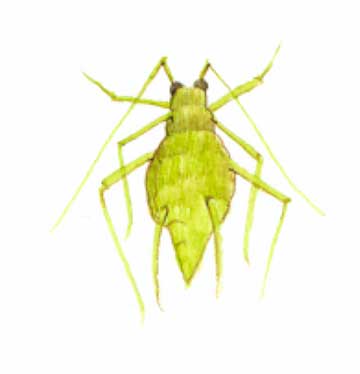 Rose Aphid
Rose Aphid
Rose aphid: The number one insect enemy in the rose garden is the rose aphid (often referred to as greenfly), a small, green, soft-bodied insect (about 1/16 inch long) often found in large colonies -- particularly on the first lush spring growth -- sucking the sap from stems. Control by washing off the stems with water or spraying with an insecticide containing acephate, diazinon, or malathion.
Plant bugs: This is a large group of insects that includes the lygus bug and stink bug. Plant bugs attack the developing bud by sucking the sap. While feeding they inject a toxic substance causing breakdown of plant tissue, distortion, and premature death of the bud. An application of a systemic insecticide such as RosePride Systemic will solve further attacks.
Downy mildew: This is perhaps the most serious fungus to invade the rose garden. It can defoliate a rose bush and continue to survive on the canes themselves. Control preventively with a fungicide. Practice good sanitation; pick up fallen leaves and prunings and dispose of them in the trash.
Copyright © www.100flowers.win Botanic Garden All Rights Reserved